Activestills photographers have been documenting the popular struggle protests against the Israeli Wall in the West Bank village of Bil’in from their inception in 2005. The following is a selection with personal stories marking 10 years of their work in the village.
The village of Bil’in will mark a decade of nonviolent protests and popular struggle on Friday, February 27, 2015.

By Keren Manor
The first time I came to Bil’in was in 2005, with the Anarchists Against The Wall group. It was also my first time in the Occupied Palestinian Territories and one of the events that completely changed my life. My strongest memory from that initial experience was the shocking realization that everything I thought and believed about the political situation in Palestine and Israel was distorted.
At the time I was studying photography and I came to the protests with my black and white film camera. I got to know more photographers, Oren, Yotam and Eduardo Suteras, who like me, kept going to the demonstrations week after week. We all shared a desire to show what was happening and try to influence public opinion in Israel and internationally. This was the point that connected us and from which the Activestills collective was founded. For me, marking 10 years of the struggle in Bil’in also marks 10 years of working together as a collective.
This picture was not taken during a demonstration but during one of my visits to the village on an off-protest day. At the time, we participated in every Friday protest, but it was important for me to also visit the village when there were fewer cameras around. I got to know the people who used to be figures in the papers, usually portrayed in a scary way. People who opened their homes and their hearts for me, whose pain I felt and in time I became their partner.
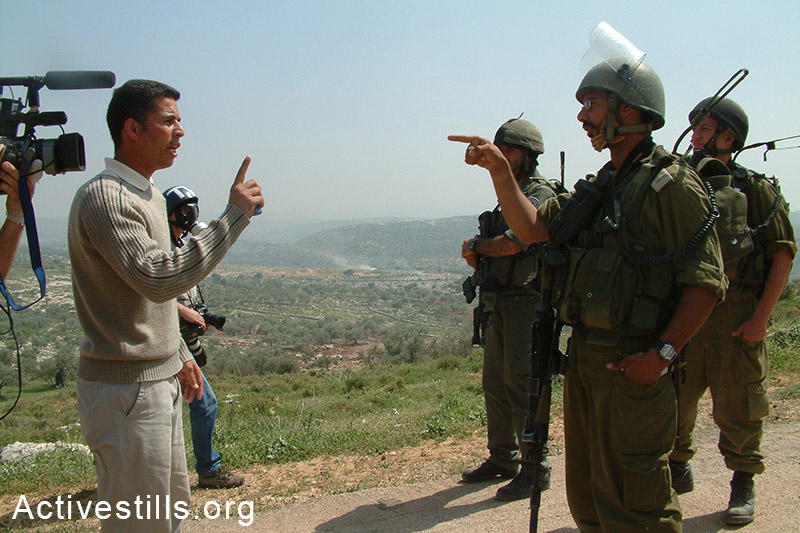
By Oren Ziv
This photo was taken at my first protest in Bi’lin. Hundreds of Palestinians and around 10 Israeli activists from Anarchists Against the Wall were marching from the center of the village to the planned route of the wall. At the time, the bulldozers had only just started their work.
I was really nervous about not knowing the area and not knowing what to expect; we were walking fast trying to keep up with the activists who led the march. As we arrived, the Israeli soldiers were getting ready to attack us, but a second before they started throwing stun grenades, Muhamad Khatib said to them in Hebrew: “Don’t shoot, it’s a peaceful protest.” The commander told him to stay back. While they were talking, the rest of the marchers made it to the construction site and the activists started to plant olive trees on the route of the wall.
Since then, I’ve marched the same route hundreds of times — from the center of Bil’in to the village’s lands, left behind the wall. My first time, however, was the only time I managed to do it without getting shot at along the way.
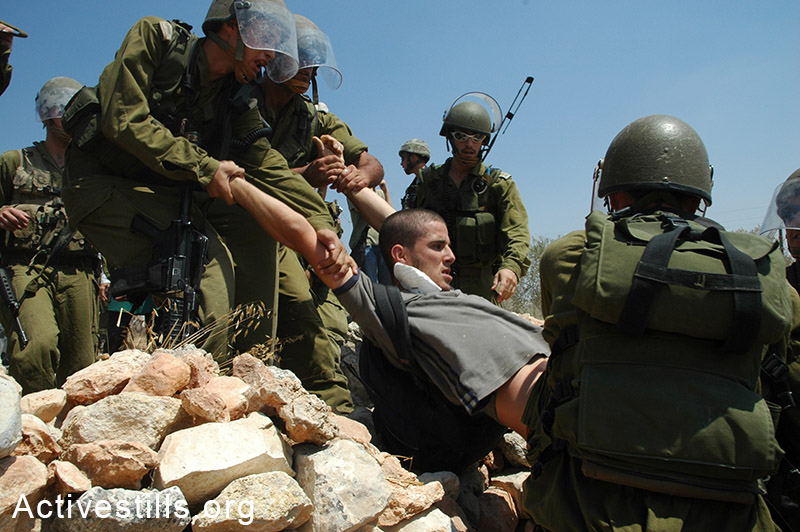
By Yotam Ronen
I choose this photo because my brother is photographed in it. This was one of the first protests I went to in Bil’in, together with him, and it was the first time I participated in any political activity in the West Bank.
My brother had been arrested a few times before, as had many other activists who I knew. My instinct was always to jump and help him, or others, trying to free them. But this photo is meaningful to me because it was one of the first times I saw somebody I knew, somebody who was part of the struggle, getting arrested and I chose to keep taking pictures. I think it was a moment in which I realized that I would always have to find the right balance between the activist and the photographer in me.

By Anne Paq
For me, Bil’in is not just any village but one that had a big impact on my decision to stay and work in Palestine. It was in Bil’in that I started to go to protests and learned about the Palestinian popular resistance.
I remember the weekly demonstration in Bil’in one day in 2007. It was the first Friday following the Israeli Supreme Court decision that ordered the state to change the route of the wall “within a reasonable period of time.” I remember the joy — activists, hand in hand, Palestinians, Israelis and internationals, singing and dancing together.
But the activists were not fooled by the court’s ruling and expressed their determination to continue the resistance until they gained back all of their lands. And it did take four more years of protest, hundreds of more demonstrations, two further court petitions, hundreds of injured and two demonstrators killed for the Israeli state to finally implement the ruling.
The fifth anniversary of the struggle took place one week after preliminary infrastructure work finally broke ground as Israel began to reroute the wall in accordance with the ruling. There was a special call for activists to join and dismantlement the wall themselves. At the height of the demonstration, protesters managed to get to the fence, dismantle a large section, and cross the wall, placing a Palestinian flag on top of an Israel army outpost. The sense of jubilation and victory was palpable. The Israeli army, however would not let the celebration continue. The soldiers responded by spraying “skunk water” and shooting scores of tear gas canisters. The scene of Israeli soldiers defending a wall that they themselves had to dismantle was so absurd.
Perhaps this dismantlement was only a small victory, but in the 10 years that I have been here, facts on the ground have only developed in one direction: more walls, more settlements, more demolitions of Palestinian homes, more illegal annexation of Palestinian lands. Therefore, a small victory on the ground carries huge promise. A promise that pressure works, that things can be changed, and that people’s power will not be defeated.
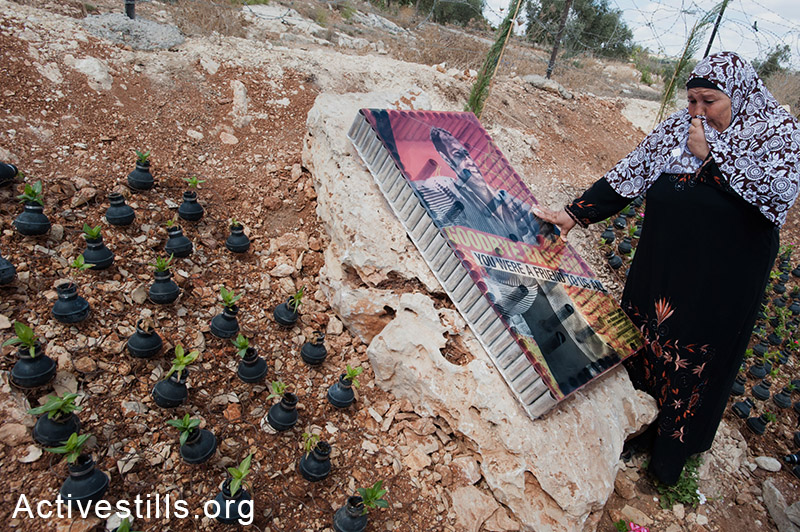
By Ryan Rodrick Beiler
Because I spent most Fridays at the less-covered weekly popular protest in Al Ma’sara, I only made it to the Bil’in demonstration once. Many journalists had already photographed Bil’in’s tear gas memorial garden. But after being there myself and seeing the coverage in the mainstream media, I just had to write an article about it. Most coverage presented the garden as a quaint artistic flourish, and failed to even identify by name the “Palestinian woman” who was watering the flowers. They failed to mention that the garden was a memorial to Bassem Abu Rahmah, on the spot where he was struck in the chest and killed by a high-velocity tear gas canister fired at him by an Israeli soldier in 2009. They did not mention that the woman watering the flowers was his mother, Subhiya. This case provides just one example of how Activestills contrasts with typical news photography: rather than just grinding out action shots or weird news click-bait, we try to step back and provide the full context — even if it’s less charming.

By Shachaf Polakow
This image was taken at the memorial service for Basem Abu Rahmah. Bassem used to welcome the international and Israeli activists who came to the protests in such a warm way, that from your first visit to Bil’in, you would feel included and welcome. The children in the image, taking part in the memorial service, are the hope and pride of the Palestinian resistance. They didn’t give up to army violence, the Israeli occupation and repression. I feel that our duty as photographers and activists, is to make sure that these youths have freedom from the occupation one day.
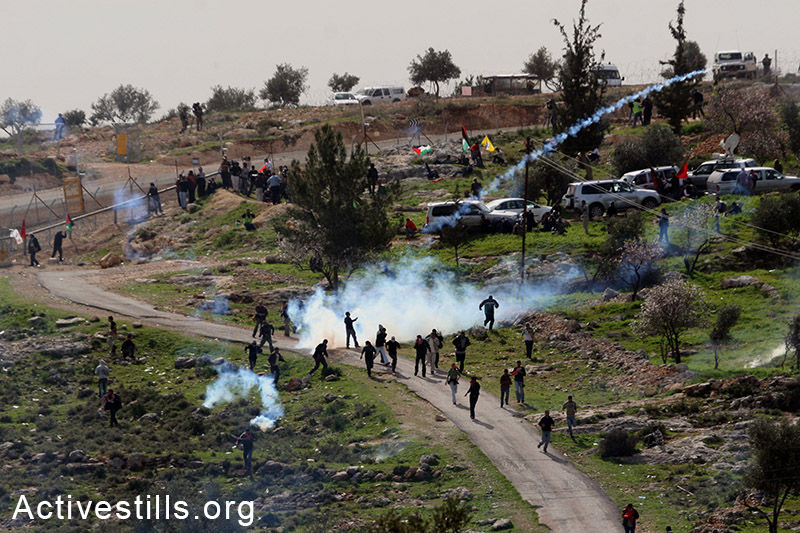
By Tess Schaflan
I photographed tear gas being shot at protesters during the third anniversary of the Bil’in struggle against the wall on Friday, February 22, 2008. I was walking on crutches that day, following a motorcycle crash and was photographing alongside fellow Activestills photographer Oren Ziv, who incidentally, was also partially disabled at the time after crashing his motorcycle. We both couldn’t move so we stayed on the back part of the protest, on a nearby hill.
We were photographing the protest from a distance, as neither of us was able to move fast enough to get closer. It was a limiting yet challenging photography exercise. It made me think about Rani Burant, a Palestinian activist from Bil’in who was confined to a wheel chair after being shot in the neck by an Israeli sniper. Rani Burant has attended and documented each and every protest in his village for the last decade.
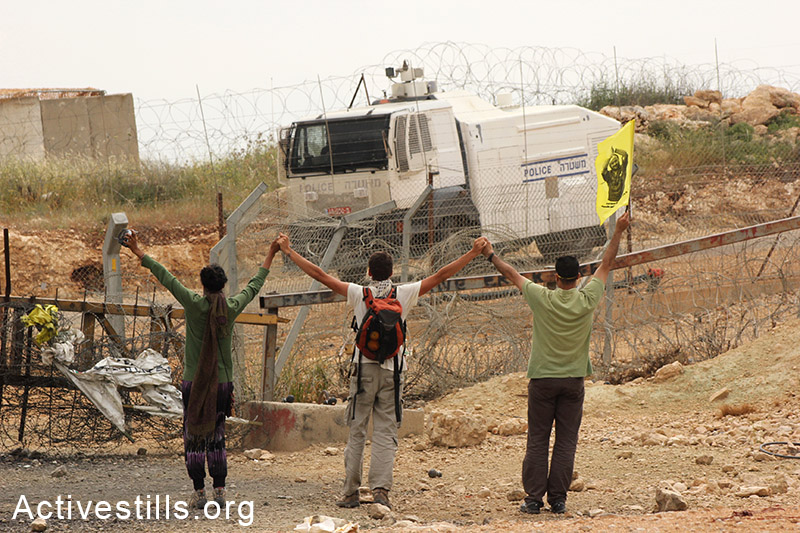
By Ahmad al-Bazz
The village of Bil’in has succeeded in becoming the symbol of the poplar struggle in Palestine. Bi’lin has attracted tens of thousands of international activists from around the world. Some of them joined the demonstrations only once, while others stayed and attended for several months or even years. In this photo you see three international activists facing a skunk water canon that would soon throw the most horrible smelly water on them. For me, to see activists from outside joining the struggle is very impressive and inspiring.
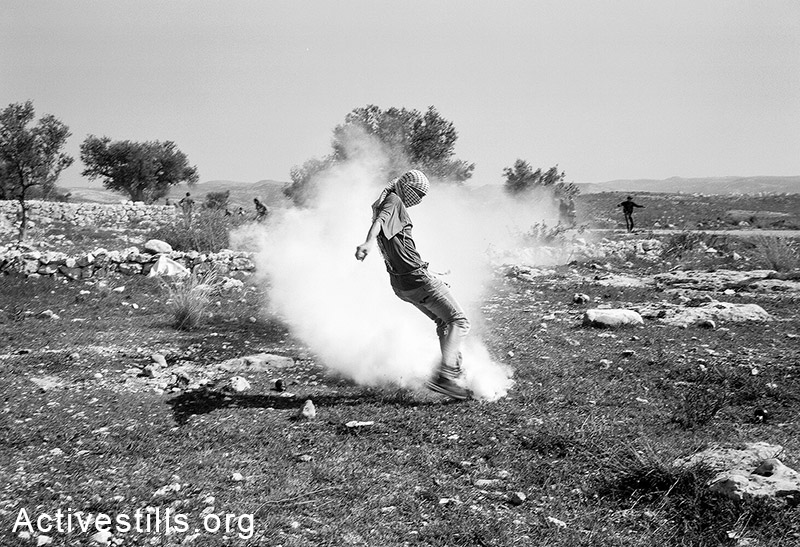
By Miki Kratsman
This image of the “kicking boy” was taken in my last visit to a protest in Bil’in, on March 2014. For me, “the kicking boy” is an image that exemplifies the gap between an event and the day-to-day routine; between what is considered a “decisive moment” — in terms of a singular photograph — and a “daily life” photo, an everyday image.
For the consumer of regular news photography, it would look like a regular news image, a small event in a Palestinian demonstration — and in a way it is. But at the same time it is a generic photo, not very specific, it becomes also an image of a ritual.
Since 2005 the Friday protests in the village of Bil’in have become a consistent tool against the Israeli occupation. As long as the day-to-day reality of the occupation is a mundane routine for Israelis, the Friday protests are a ritual for these brave Palestinian activists, who are insistent that their voices be heard. For this reason the “kicking boy” is not a “decisive moment” photo, as it may look, but a moment of daily life. That is why this somewhat expected Friday image, becomes also for me, a ritualistic photograph.
Read also:
The Wall, 10 years on
IDF: Palestinian nonviolent protest is an ideological crime
Bil’in activists remember Kayla Mueller, her time in Palestine

